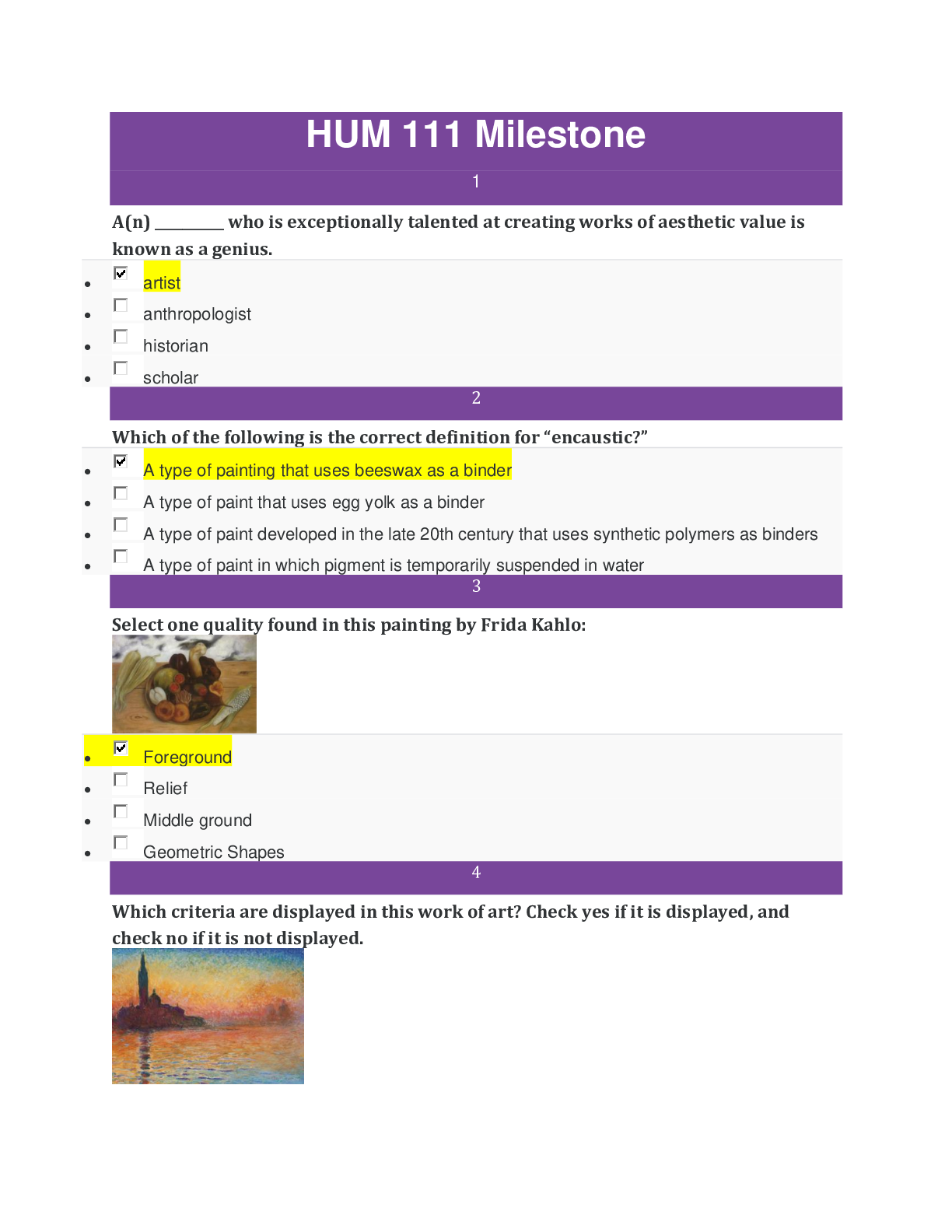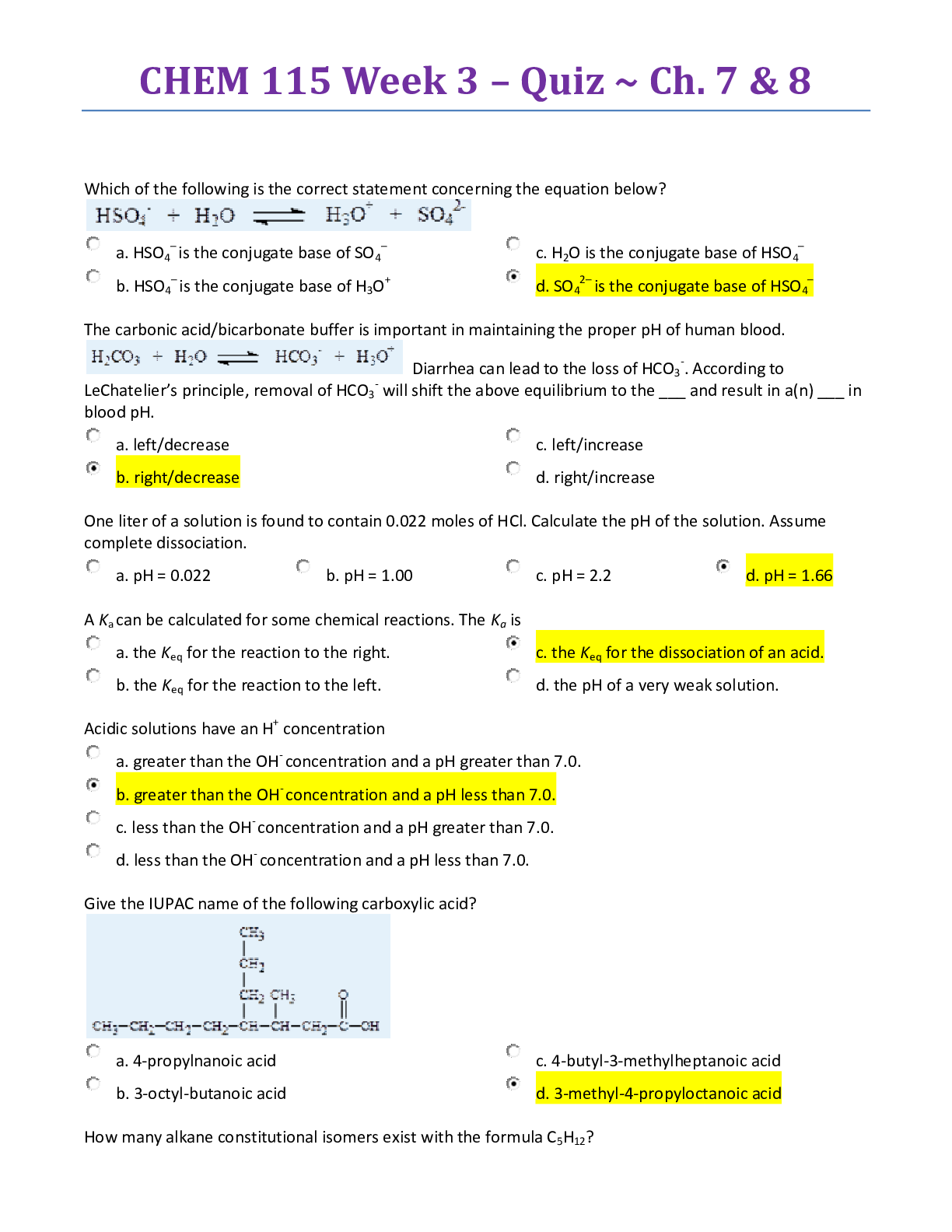*NURSING > QUESTIONS & ANSWERS > IER A, Questions and answers, 2022 update, QuestionsBank. 100% PASS RATE (All)
IER A, Questions and answers, 2022 update, QuestionsBank. 100% PASS RATE
Document Content and Description Below
IER A, Questions and answers, 2022 update, QuestionsBank. 100% PASS RATE a fracture of the proximal humerus, which has healed well. Upon examination, the therapist notes limitation in active shou... lder flexion. The scapula protracts, elevates and upwardly rotates early and elevates excessively when the patient attempts to lift the arm. The NEXT thing the therapist should do - ✔✔-Limitation of active shoulder flexion can be due to weakness (less than 3/5 strength) of any of the following muscles;deltoid, supraspinatus, serratus anterior and upper trapezius. However, the loss of active shoulder flexion could also be due to capsular restrictions. A patient who sustained a proximal humerus fracture and resulting immobilization would likely have a capsular restriction as well as muscle atrophy. *Performing passive shoulder flexion and glenohumeral accessory mobility testing will help determine the tissue( s) at fault*. If there are restrictions in passive shoulder flexion and capsular restrictions, a program including joint mobilization is appropriate. Incorrect Choices: -Manual muscle test of serratus anterior and rhomboids. Certainly, restricted shoulder flexion could be due to weakness in the serratus anterior. However, a weak serratus anterior would result in retraction of the scapula and possible winging, not protraction and upward rotation of the scapula. In addition, the rhomboids are downward rotators, retractors and elevators of the scapula. -Manual resistance exercises for the supraspinatus and infraspinatus. This treatment would be appropriate for weakness of the rotator cuff. -Large amplitude oscillations performed at the end-range of joint play for the glenohumeral inferior and posterior capsule. This treatment would be appropriate for capsular restrictions. In what position should the knee be placed when performing a valgus stress test for the medial collateral ligament? - ✔✔The medial collateral ligament is the primary restraint of valgus movement with the knee in 20 -30 flexion. =In less than 20 of knee flexion, the bony congruency of the knee and the cruciate ligaments contribute significantly to resisting a valgus force. =In greater than 30 of flexion, the joint capsule contributes significantly to resisting a valgus force. sensory changes secondary to left CVA. Upon testing, the patient is unable to detect pinprick or temperature in the right hand, leading to disuse and increased safety risk - ✔✔Correct Answer: *Anal*gesia refers to a complete loss of pain sensibility (in this case); N;paining in anal Incorrect Choices: -Anesthesia is a more global term referring to loss of sensation.(마취제) - Abarognosis refers to an inability to recognize weight. -Allodynia refers to pain produced by a non-noxious stimulus (e.g., light touch). important predictor for lymphedema after treatment for breast cancer - ✔✔Correct Answer; Obesity is consistently reported as a predictor of lymphedema after modified radical mastectomy for breast cancer. Weight management should be an integral part of patient education. restricted left rotation of the C7-T1 spinal level. After stabilizing the thoracic spine, the therapist's hand placement for mobilization to improve left rotation should be at the - ✔✔Correct Answer: The most effective hand placement for mobilization into greater left rotation is at the posterior aspect of the *right C7 articular pillar* because it rotates the C7 vertebra to the left. Incorrect Choices: -Hand placement on the left of C6 or C7 articular pillars will promote right rotation. -Hand placement on the Tl spinous process will create a posteroanterior glide, which will promote flexion at the Tl-2 segment and extension at the C7-Tl segment appropriate fine motor behavior that should be established by 9 months of age is the ability - ✔✔Correct Answer: Transferring objects from one hand to another is a task developmentally appropriate for an 8-or 9-monthold. Incorrect Choices: -A fine pincer grasp is an 11-month skill -stacking 2 blocks is a 12-15 month skill, while stacking 6 blocks is a 16-24 month skill. -Holding a cup by the handle while drinking usually occurs by 12 months of age 10-year history of Parkinson's disease (PD) has been taking levodopa (Sinemet) for the last 5 years. The patient presents with deteriorating function and is no longer able to walk independently due to constant and uncontrolled involuntary movements. During the examination, the PT observes that the *patient is restless, with constant dancing, hyperkinetic movements of his legs*. The therapist's BEST course of action is to - ✔✔Correct Answer: Dyskinesias (involuntary movements) are caused by an adverse effect of prolonged use of dopamine. Document the observations and refer the patient back to the physician for possible medication adjustment. Incorrect Choices: -Selegiline is used in early PD; its main adverse effects include nausea, dry mouth, dizziness, anxiety and hallucinations. Failure to notify the physician of these documented adverse effects can jeopardize the patient's functional outcomes and safety. Which of the following is a correct reason to terminate a maximum exercise tolerance test for a patient with pulmonary dysfunction - ✔✔Correct Answer: A maximum exercise tolerance test is a sign- or symptom-limited test. Dyspnea with a drop of 20 mm Hg in Pa02 is an indication for stopping the test. Incorrect Choices: -Achieving age-adjusted predicted maximum HR is not a sign or symptom, and therefore does not stop the test. -HR is expected to increase with normal rhythm. - ST segment depression, not a flat ST segment, reveals ischemia and would be a reason to stop the test patient is able to walk independently with an assistive device in the hall outside the PT gym. When asked to walk across the hospital lobby and through a revolving door, the patient slows down considerably and stops by the revolving door, unable to proceed. The therapist determines - ✔✔Correct Answer: Open motor skills are movement skills that can be performed in a variable, changing environment. Externally paced skills must comply with timing demands from the environment (e.g., walking through a revolving door). Incorrect Choices: -Closed motor skills are movement skills that are performed in a stable, nonchanging environment. -Serial skills are movements that combine a series of discrete elements, with a specific order of elements. -Continuous skills are movement skills that appear to have no recognizable beginning or inherent beginning and end. presents with an enlargement in the neck in the area of the Adam's apple. The growth is resulting in difficulty while eating and episodes of dyspnea. The patient also has abnormal protrusion of the eyes - ✔✔Correct Answer: Graves' disease is caused by excess secretion of thyroid hormone (hyperthyroidism) and produces a number of clinical manifestations. Difficulty eating, mild facial edema, and abnormal protrusion of the eyes ( exophthalmos) are classic signs. Other symptoms can include heat intolerance, nervousness, weight loss, muscle weakness and fatigue, tremor and palpitations. Incorrect Choices: -Chronic autoimmune thyroiditis (Hashimoto's disease) causes hypothyroidism. A number of clinical manifestations can occur,including muscle weakness and fatigue. -Patients with fibromyalgia can also develop hypothyroidism. -Hyperparathyroidism is caused by overactivity of the parathyroid glands, leading to elevated serum calcium levels (*hypercalcemia, increased bone absorption*, hypercalciuria) and decreased serum phosphate levels. body mass index (BMI) of 33 kgjm-2 is referred to an outpatient exercise program. The PT in charge of the program recognizes this patient is at increased risk for - ✔✔Correct Answer: 1 A patient with a BMI of 33 kgjm-2 is obese (BMI > 30 kgjm-2) and is at increased risk for hyperthermia- during exercise (as well as orthopedic injury). hyperthermia - ✔✔Abnormally high body temperature patient with metabolic syndrome is participating in a circuit-training program involving both aerobics and strength training. The therapist notices that the patient is sweating and having difficulty concentrating on an activity and coordinating movements. When asked if there is a problem, the patient is confused and has difficulty speaking. The therapist should - ✔✔*Metabolic syndrome (prediabetic state*) is characterized by central obesity, insulin resistance, and dyslipidemia. Individuals with metabolic syndrome may develop hypertension and reactive hypoglycemia (as in this case) in response to exercise. -Signs and symptoms of hypoglycemia include difficulty concentrating and speaking, confusion and developing incoordination. -*The therapist should sit the patient down and administer fruit juice immediately* complains of back pain, the PT notes pain with end-range active range of motion (AROM) into left hip flexion, abduction and external rotation. The origin of the pain is MOST LIKELY the: - ✔✔Correct Answer: Pain at *end-range* of flexion, abduction, external rotation and extension *(FABERE test) is diagnostic for SI joint dysfunction because it both gaps and compresses the joint*. =M:*S*I is south asia far away-end range-from ny. Incorrect Choices: -*Pain at the midrange into hip flexion, abduction and external/lateral rotation suggests hip joint pathology*. -Patient reported low back pain, and if the sartorius or the hip were involved, the complaint of pain would have been reported in the anterior and medial thigh. -Renal pain is often referred to the costovertebral region, flank, or lower abdominal quadrant. During which phases of the gait cycle would a physical therapist expect to observe an everted posture of the calcaneus? - ✔✔Correct Answer: Calcaneal eversion is a component of the triplanar motion described as rearfoot pronation. During the gait cycle, rearfoot pronation, caused by normal ground reaction forces, occurs from initial contact (heel strike) through loading response (foot-flat). During clinical examination, the nonmodified Ober's test is BEST used to assess for loss of extensibility of the - ✔✔Correct Answer: Ober's test is used to assess the extensibility of the tensor fascia lata and iliotibial band and is performed with the patient in a side-lying position with the lower leg flexed at the hip and the knee for stability. The upper leg is passively abducted and slightly extended at the hip with the knee flexed to 90° (or extended). The examiner stabilizes the pelvis and allows the upper limb to slowly lower. The test is considered positive when the examined leg fails to lower beyond horizontal. The leg will remain abducted if the tensor fascia lata and iliotibial band are tight. factory worker injured the right arm in a factory press with damage to the ulnar nerve at the elbow. A diagnostic electromyogram (EMG) was performed 3 weeks after the injury, with evidence of spontaneous fibrillation potentials. In this case, the PT recognizes that - ✔✔Correct Answer: Spontaneous fibrillation potentials and positive sharp waves present on EMG 2-3 weeks after injury are evidence of denervation. This occurs with axonotmesis, a class 2 peripheral nerve injury (PNI) with axonal damage and Wallerian degeneration distal to the lesion. Incorrect Choices: -Polyphasic motor units of low amplitude and short duration are evidence of reinnervation. -Neurapraxia is a class 1 PNI with local compression or blockage. EMG typically reveals no spontaneous activity patient is recovering from a right cerebrovascular accident (CVA), resulting in severe left hemiplegia and visuospatial deficits. In addition, there is a large diabetic ulcer on the left foot with pitting edema. The BEST choice for wheelchair prescription for this patient - ✔✔Correct Answer: A hemiplegic chair has a low seat height (17 1/2 inches as compared with the standard seat height of 19 inches) and is the best choice for this patient. The patient propels it with the sound right hand and leg. An elevating leg rest on the left is indicated for edema. Incorrect Choices: - A one-arm drive wheelchair has both drive mechanisms located on one wheel. The patient can propel the wheelchair by using one hand. It is *contraindicated in patients with cognitive or perceptual deficits* (as in this case). -The electric wheelchair with joystick might also work but is significantly more expensive and less transportable and would also require increased maintenance. - The seat height of a standard height wheelchair (lightweight active duty wheelchair) would be too high to allow propulsion using the sound foot and hand. slump test on a patient with a diagnosis of lumbar disc herniation whose complaint is pain in the posterior thigh. Which of the following findings would indicate a positive test result? - ✔✔Correct Answer: a positive slump test would result from pain in the posterior thigh that is relieved with cervical extension current patient is anterior cruciate ligament (ACL) deficient in the right knee. Which of the following tests would be UNNECESSARY for determining whether the ACL was ruptured? - ✔✔Correct Answer: The *anterior drawer test places the knee in 90 of flexion. In this position, the knee joint capsule is the primary constraint to movement*, so performing this test may result in a false-negative determination. Incorrect Choices: 1. Lachman's test. 3. Slocum's test. 4. Lateral pivot shift test are appropriate to assess the integrity of the ACL elderly patient has been hospitalized for the past 3 days with pneumonia. The physician and patient are hoping for a home discharge tomorrow. The patient lives with her sister in a first-floor apartment. The PT has determined that ambulation status is independent with rolling walker and endurance is only up to 15 feet, not enough to allow the patient to get from the bed to the bathroom (a distance of 20 feet). The therapist should recommend - ✔✔Correct Answer: Environmental modifications (the addition of a commode) and assistance of a home care aide should allow the patient to safely return home. Home physical therapy should focus on improving endurance to regain independence in the home. Treatment in the home is the most cost-effective in this case. A PT examines a patient with a right CVA and determines that the patient has a profound deficit of homonymous hemianopsia. The BEST INITIAL strategy to assist the patient in compensating for this deficit is to - ✔✔Correct Answer: -A patient with homonymous hemianopsia needs to be made aware of the deficit and instructed to turn the head to the affected left side (a compensatory training strategy). Incorrect Choices: -Initial strategies include placing items on the right (unaffected side), not the left side, so that the patient can successfully interact with the environment. Later, as there is ability to compensate, items can be moved to midline, and finally to the affected left side. multiple sclerosis (MS) exhibits moderate fatigue during a 30-minute exercise session - ✔✔Correct Answer: Common problems in MS include fatigue and heat intolerance. Exercise intensity should be reduced, and a distributed practice schedule should be used, in which rest times equal or exceed exercise times. Incorrect Choices: A massed practice schedule in which the exercise time exceeds the rest time is contraindicated as is a warm environment or warm pool, which can increase fatigue. adult is running a marathon race and collapses well short of the finish line. *Ambient temperature is 92 degree and body temperature is measured at 101F*. This individual has a rapid pulse and rapid respirations. Skin feels warm and dry. When questioned by the PT who is helping monitor the runners, the individual is confused. - ✔✔Correct Answer: This individual is demonstrating signs and symptoms of *dehydration (inadequate fluid intake) and hypovolemic shock*. Pulse and respirations are increased; blood pressure (BP) may decline. Restlessness, anxiety and confusion may all be present. Incorrect Choices: -Hypervolemia is an abnormal increase in the volume of circulating blood. -Anaphylactic shock is a severe hypersensitivity (allergic reaction) to a substance with symptoms of local allergen-antibody interaction (hives, edema, warmth, erythema) as well as systematic symptoms of flushing, wheezing, dyspnea and anxiety. -Septic shock (sepsis) is a systematic inflammatory response to infection characterized by fever, tachycardia, tachypnea and organ failure. patient with superficial partial-thickness burns over 20% of the trunk. The correct identification of this burn type by surface appearance characteristics includes - ✔✔Correct Answer: The surface appearance of a superficial partial-thickness burn is characterized by intact blisters and moist, weeping or glistening surface when blisters are removed. Incorrect Choices: - A dry surface with no blisters is characteristic of a superficial burn. -A wet surface with broken blisters is characteristic of a deep partial-thickness burn. -Parchment-like, leathery and dry surface is characteristic of a full-thickness burn from stroke is having difficulty bearing weight on the left leg. The patient is unable to advance the tibia forward and abbreviates the end of the stance phase on the left going directly into swing phase. The MOST LIKELY cause of the patient's problem is: - ✔✔Correct Answer: Forward advancement of the tibia from midstance to heel-off is controlled by eccentric contraction of the plantarflexors; from heel-off to toe-off, the plantarflexors contract concentrically. Either spasticity or contracture of the plantarflexors would limit this forward progression. Patients compensate by going right into swing, typically with a circumducted gait or with increased hip and knee flexion because there is no pushoff. Incorrect Choices: -Spasticity or contracture of the dorsiflexors is typically not seen, and could not cause this deficit. -Weakness of the hip extensors would be evident at heel strike, with a backward lean of the trunk traction injury to the anterior division of the brachial plexus, the PT would expect to see weakness of the elbow flexors, wrist flexors, and forearm pronators. The therapist would also expect to find additional weakness in - ✔✔Correct Answer: Thumb abductors are innervated by the median nerve, primarily by the C6 nerve root. The anterior divisions contribute to nerves that primarily serve flexors and, in this case, the thumb. Incorrect Choices: All other choices are innervated by nerves off the posterior division. -Wrist extensors include the extensor carpi radialis longus (ECRL), extensor carpi radialis brevi (ECRB), innervated by the radial nerve C6-7 and the extensor carpi ulnaris (ECU), innervated by the radial nerve C6-8. -Supination results from action of the biceps brachii (musculocutaneous nerve C5-6) and the supinator (radial nerve C6). agitated patient with dementia inx - ✔✔An agitated patient with dementia does not process information easily. *A calm and supportive approach with low-level commands (one or two actions)* provides the best approach for this patient She is currently taking a tricyclic antidepressant medication (amitriptyline) and has a recent history of a fall. The PT suspects the precipitating cause of the fall is the medication, because it can cause - ✔✔Correct Answer: Most tricyclic antidepressants have significant anticholinergic and sedative properties and may cause lethargy, sedation, arrhythmias, *hypotension* and blurred vision, thus increasing fall risk-> *Postural hypotension* The elderly are particularly susceptible to adverse drug effects because of a multitude of factors. congestive heart failure (CHF). Digitalis (digoxin) has been prescribed to improve heart function. The patient will demonstrate understanding of the adverse side effects of this medication by recognizing the importance of contacting the primary physician with the appearance of which of the following symptoms - ✔✔Correct Answer: Weakness and palpitations =slowdown of heart causes papitayion n weakness dut to less blood flow *Digitalis (digoxin) is frequently used to treat CHF (it slows HR and increases force of myocardial contraction*). (HIV) is hospitalized with a viral infection, and has a history of four infectious episodes within the past year. The PT recognizes that ongoing systemic effects are likely to include - ✔✔Correct Answer: Repeat infections produce a chronic inflammatory state. Systemic effects include *low-grade fever, weight loss, malaise, anemia, fatigue*, leukocytosis and lymphocytosis. Incorrect Choices: -Inflammatory activity can be detected by an elevated ESR. -Redness, warmth, swelling and pain are signs of acute inflammation. -Fever, tachycardia and a hypermetabolic state are signs of the systemic effects of an acute inflammation. with active hepatitis B infection. Transmission of the disease is best minimized if the PT Wears gloves during any direct contact with blood or body fluids - ✔✔Correct Answer: *glove, gown, mask*. Standard precautions specify that health care workers wear personal protective equipment (moisture resistant gowns, masks) for protection from the splashing of blood, other body fluids or respiratory droplets resulting from direct body contact with the patient. Incorrect Choices: The patient with risk of transmission of known or suspected infectious agents is typically isolated in a single-patient room and wears protective equipment (masks) only when being transported out of the room. pain (7/10) and limited range of motion (ROM) of the right shoulder as a result of chronic overuse. The PT elects to use procaine hydrochloride iontophoresis as part of the intervention for this patient's problems with Continuous monophasic current, with the medication under the anode - ✔✔Correct Answer: Because like charges are repelled, the positively charged medication would be forced into the skin under the positive electrode (anode). A continuous, unidirectional current flow is very effective in repelling ions into the skin. Procaine is a positive medicinal ion, and will be repelled from the anode (positive pole). Incorrect Choices: A pulsed, interrupted or bidirectional current generates less propulsive force owing to the discontinuous nature of the current. N;나는 아프다. 나(negative) 아프다(anode) Negative는 애니와 데니와 데이트하다 CONTRAINDICATION to initiating extremity joint mobilization on a patient with chronic pulmonary disease may include - ✔✔Correct Answer: *Very often, patients with chronic pulmonary disease have been managed using corticosteroid therapy*. Longterm steroid use has the catabolic effects of osteoporosis, weakened supporting joint structures and muscle wasting, making joint mobilization contraindicated. Incorrect Choices: -Inhalation therapy, even with a corticosteroid, has minimal systemic uptake of the drug and, therefore, would not be a contraindication to performing joint mobility. -A functionally limited thorax may be considered when deciding on the starting body position for joint mobility, but will not change the ability to perform the task. patient has a 4-year history of taking nonsteroidal anti-inflammatory drugs (NSAIDs) such as aspirin for joint pain, and recently began taking a calcium channel blocker (verapamil). The IT examines the patient for possible adverse reactions/side effects that could include - ✔✔-Stomach pain, bruising, confusion Correct Answer -With advanced age, the capacity of the individual to break down and convert drugs diminishes (secondary to decreased liver and kidney function, reduced hepatic and renal blood flow, etc.). -Some drugs additionally slow metabolism (e.g., calcium channel blockers like verapamil and diltiazem or antigout drugs like allopurinol). presents to the emergency room with complaints of fever, shaking chills, and a worsening productive cough. Complaints of chest pain over the posterior base of the left thorax are made worse on inspiration. An anteroposterior x-ray shows an infiltrate on the lower left thorax at the posterior base. This patient's chest pain is MOST LIKELY caused by - ✔✔Correct Answer: The case is supportive of a pulmonary process as evidenced by radiography and history. Because the radiographic findings and the pain are in the same vicinity and worsen with inspiration, the likelihood is that this pain is pleuritic in origin. *Infected pleura*(pleuritis) elderly and frail resident of an extended care facility presents with hot, red and edematous skin over the shins of both lower extremities. The patient also has a mild fever. The MOST LIKELY cause of the symptoms - ✔✔Correct Answer: Cellulitis is an inflammation of the cellular or connective tissue in or close to the skin. It is characterized by skin that is hot, red, and edematous. Fever is a common finding. Incorrect Choices: -Dermatitis produces red, weeping, crusted skin lesions, but is not commonly accompanied by fever. -Location on shins makes herpes an unlikely choice, and there are no skin eruptions or vesicles. -Scleroderma is a collagen disease producing tight, drawn skin 10-year-old presents with pain ( 4/10) and limited knee ROM following surgical repair of the medial collateral ligament and ACLs. In this case, the modality that can be used with PRECAUTION - ✔✔Correct Answer: Low-dose ultrasound (US). 4 Because the epiphyseal plates do not close until the end of puberty, US energy should be applied with caution around the epiphyseal area due to its potential to cause bone growth disturbances. However, there is no documented evidence that US creates any direct untoward effects on the growth plates, especially if applied at low dosage. Incorrect Choices: Electrical stimulation or deep thermotherapy would have no deleterious effects on the epiphyseal plates, because no mechanical effects on hard tissue are associated with their use weight lifter exhibits marked hypertrophy after embarking on a strength training regime. Hypertrophy can be expected to occur following at least - ✔✔Hypertrophy is the increase in muscle size as a result of resistance training, and can be observed following at least 6-8 weeks of training. Individual muscle fibers are enlarged, contain more actin and myosin and have more larger myofibrils. BEST shoulder position to expose the tendon of the long head of the biceps for application of phonophoresis would be - ✔✔The long head of the biceps is best exposed in shoulder lateral rotation and extension, due to its attachment at the supraglenoid tubercle of the scapula, which is at the *medial aspect of the shoulder joint* traumatic brain injury (TBI), a patient is unable to bring a foot up onto the next step during a training session on stair climbing. The BEST course of action to promote learning of this task is to have the patient practice - ✔✔Correct Answer: Step-ups onto a low step while in the parallel bars. Active task-specific practice of stepping using a low step represents the best choice to ensure motor learning. Incorrect Choices: -Passively bringing the foot up does not promote active learning. - Marching in place and balance on stairs are appropriate lead-up skills to stair climbing, but are not task-specific practice. with decreased ankle dorsiflexion range of motion following a repair of the Achilles tendon that is now well healed. Which joint, in addition to the talocrual joint, should be assessed as a likely contribution to the restricted range - ✔✔The distal tibiofibular joint must separate slightly with ankle dorsiflexion in order to allow the talus to pass between the articulating surfaces of the malleoli the rehabilitation team visits the home and finds three standardheight steps going into his home. A ramp will have to be constructed for wheelchair access. The recommended length of this ramp should be - ✔✔architectural standard for rise of a step is 7 inches (steps may vary from 7-9 inches). The recommended ratio of slope to rise is 1:12 (an 8% grade). For every inch of vertical rise, 12 inches of ramp will be required 3X7X12=252 inches wrestler has been taking anabolic-androgenic steroids for the past 6 months to build muscle and improve performance. The PT working with the team suspects illegal drug use and examines the athlete for - ✔✔Correct Answer - Rapid weight gain, marked muscular hypertrophy and mood swings = Signs and symptoms of anabolic steroid use include rapid weight gain, elevated BP, acne on the face and upper back and changes in body composition with marked muscular hypertrophy, especially in the upper body. Additional signs include frequent bruising, needle marks, male breast enlargement, or in females, secondary male characteristics and menstrual irregularities. -With prolonged use, jaundice or changes in personality (mood swings, rages) may develop diagnosis of left-sided CHF, class II, is referred for physical therapy. During exercise, this patient can be expected to demonstrate - ✔✔Correct Answer: Dyspnea with fatigue and muscular weakness 4 Left-sided heart failure is the result of the left ventricle failing to pump enough blood through the arterial system to meet the body's demands. It produces pulmonary edema and disturbed respiratory control mechanisms. Patients can be expected to demonstrate progressive dyspnea ( exertional at first, then paroxysmal nocturnal dyspnea), fatigue and muscular weakness, pulmonary edema, cerebral hypoxia and renal changes. Incorrect Choices: -Severe chest pain and shortness of breath are symptoms of impending myocardial infarction (MI). - *Weight gain with dependent edema and anorexia, nausea with abdominal pain and distension are associated with right sided* PT is instructing a student in proper positioning to prevent the typical contractures in a patient with a transfemoral amputation. The therapist stresses positioning the patient in - ✔✔Correct Answer: Prone-lying with the residual limb in neutral rotation 1 The typical contractures with a transfemoral amputation are hip flexion (typically from too much sitting in a wheelchair). The residual limb also rolls out into abduction and external rotation. When in bed, hip extension should be emphasized (e.g., prone-lying). When sitting in the wheelchair, neutral hip rotation should be emphasized (e.g., using an abductor roll). Time in extension (prone, supine, or standing) should counterbalance time sitting in a wheelchair. Incorrect Choices: -Resting in supine with the residual limb resting on a small pillow in a position of hip flexion is contraindicated, as is an adductor roll in wheelchair sitting. patient who is insulin-dependent. In a review of the patient's medical record, the therapist notices that the blood glucose level for that day is 310 mg/dL. The therapist's BEST course of action is to - ✔✔Correct Answer: Postpone therapy and consult with the medical staff as soon as possible -3 Normal fasting plasma glucose is less than 115 mg/dL, while a fasting plasma glucose level greater than 126 mg/dL on more than one occasion is indicative of diabetes. around 120mg/dl -*This patient is hyperglycemic with high glucose levels(250 mg/dL). Clinical signs that may accompany this condition include ketoacidosis (acetone breath) with dehydration, weak and rapid pulse, nausea/vomiting, deep and rapid respirations (Kussmaul's respirations), weakness, diminished reflexes and paresthesias*. -The patient may be lethargic and confused, and may progress to diabetic coma and death if not treated promptly with insulin. -Physical therapy intervention is contraindicated; exercise can lead to further impaired glucose uptake.= d/t ex uses up insulin that can be used to burn glucose. Incorrect Choices: Ambulation is contraindicated. newborn with whole arm paralysis is referred for physical therapy. INITIALLY, the plan of care (POC) should include - ✔✔Correct Answer: Partial immobilization of the limb across the abdomen, followed by gentle ROM after immobilization 1 Paralysis of the upper limb typically results from a traction injury at birth, causing a brachial plexus injury. Variations include Erb-Duchenne or Erb's paralysis (affecting C5-C6 roots), whole arm palsy (affecting C5-T1 roots), and Klumpke's paralysis (affecting the lower plexus nerve roots, C8 and T1 ). Incorrect Choices: -Mobilization in overhead motions is contraindicated. -Splinting the shoulder in abduction leads to formation of abduction contractures and later hypermobility of the shoulder. -Age-appropriate task training can follow after the initial treatment. It is most important for the physical therapist to educate a client who recently had a radical lymph node dissection secondary to prostate cancer to - ✔✔Correct Answer: Closely monitor any changes in the fitting of their socks or shoes - Seventy percent of men after a radical lymph node resection for prostate cancer will develop lymphedema in one or both lower extremities and potentially the genitals. -Early changes include a perception of heaviness of the limb and an inability to wear old socks or shoes due to tightness. These are often precursors to clinically significant swelling. *Incorrect Choices*: -Although circumferential measurements are important, they are not sensitive to small accumulations of lymphedema. -Significant accumulation of lymphedema is recognized by greater than a 2.0 em difference at one measurement point between upper extremity (UE) limbs and 1.0-1.5 em difference between lower extremity (LE) limbs. -Use of alkaline soaps will result in loss of normal pH of skin (slightly acidic), drying of the skin, and increased risk of bacterial infection due to breaks in skin. - Use of compression pumps at pressures higher than 60 mm Hg can cause damage to the lymphatic vessels. She is using a single-case experimental design with an A-B-A-B format. Her research hypothesis states that pain-rating scores will decrease with the treatment intervention. Acceptance of this hypothesis would be indicated if - ✔✔In an A-B-A-B single-subject design, A represents multiple baseline measurements, and B represents multiple posttreatment measurements. If the hypothesis is accepted, the pain-rating scores will be lower following treatment compared with the baseline measurements patient is recovering from stroke and demonstrates good recovery in the lower extremity (out-of-synergy movement control). Timing deficits are apparent during walking. Isokinetic training can be used to improve - ✔✔Correct Answer: Rate control at varying movement speeds 2 Patients during recovery from stroke frequently exhibit problems with rate control during walking. *They are able to move at slow speeds, but as speed of movement increases, control decreases*. An isokinetic device can be an effective training modality to remediate this problem. Incorrect Choices: Both initiation of movement and reaction time may be impaired, but are not the likely cause of timing deficits during speed changes while walking. elderly patient with a transfemoral amputation is having difficulty wrapping the residual limb. The PT's BEST course of action is to - ✔✔Correct Answer: A shrinker is a suitable alternative to elastic wraps. It is important to select the right size shrinker to limit edema and accelerate healing. Incorrect Choices: -An Unna's paste dressing is applied at the time of initial surgery. -Use of a temporary prosthesis should be a prosthetic team decision and is based on additional factors such as age, balance, strength, cognition, and so forth. -Continuing to teach elastic bandage wrapping may be inefficient and ultimately fruitless, since the patient is elderly patient with peripheral vascular disease has been referred for conditioning exercise. The patient demonstrates moderate claudication pain in both legs following a 12-minute walking test. The MOST beneficial exercise frequency and duration for this patient - ✔✔Correct Answer: times/week, BID 10 minutes/session - Patients with vascular insufficiency and claudication pain should be encouraged to walk daily, 2 to 3 times/ day. -Duration should be short. -The patient should walk to the point of maximum tolerable pain, and be allowed to rest. spondylolisthesis - ✔✔correct choice The spinal defect is spondylolisthesis, and the radiographic view that demonstrates the Scotty dog neck fracture is the *oblique view*. Incorrect Choices: A lateral radiographic view will show the degree of anterior or posterior slippage of one vertebra on another, *allowing the radiologist to grade the spondylolisthesis*. presents with pronounced muscle weakness and wasting in the lower extremities, hypertension and a moon-shaped face with truncal obesity. The therapist recognizes these symptoms as characteristic of - ✔✔Correct Answer: Cushing's syndrome causes a variety of signs and symptoms including hypoglycemia, *hypokalemia*, hypertension, muscle weakness and wasting. Abnormal fat distribution (moon-shaped face, truncal or central obesity) is a visible clinical feature. Incorrect Choices: -Addison's disease, primary adrenal insufficiency, causes insufficient release of cortisol and aldosterone from the adrenal glands with widespread clinical manifestations, including hypotension, weakness, anorexia and nausea and vomiting. -Type II diabetes also causes weakness and fatigue along with polyuria, and other symptoms. It is associated with abdominal obesity but not moon-shaped face. - Mild hypoparathyroidism is asymptomatic while chronic hypoparathyroidism produces *hypocalcemia* and neuromuscular irritability (tetany) patient felt an immediate sharp pain in the right lower back. The following morning, the patient reported stiffness, with easing of pain after taking a shower. Based on this information, the source of the pain is MOST LIKELY - ✔✔Correct Answer: Facet joint dysfunction is *exacerbated with sustained positions, and eases with movement*. Progressive increase in activity intensifies the pain. Incorrect Choices: -Stress fracture pain is worse when weight-bearing, and is not necessarily worse in the morning. - Nerve root involvement would cause radiating pain to the extremity. - The spinal cord has no innervation and is not a source of pain When conducting the anterior drawer stress test at the ankle one week following acute inversion injury, the physical therapist is attempting to test mechanical stability provided primarily by the - ✔✔Correct Answer: - *The anterior talofibular ligament (ATFL) provides the main restraint to anterior lateral translation of the talus within the mortise*. -Passive anterior translation of the talus is performed in 20 o of plantarflexion. Excessive anterior translation of the talus during an anterior drawer test is considered indicative of significant laxity or rupture of the ATFL, and the test appears to be the most useful when performed within 4-7 days of the initial injury. Incorrect Choices: -The calcaneofibular ligament acts as the primary restraint to inversion when the ankle is in neutral or dorsiflexion and limits talar tilt. Testing of lateral talar tilt would be performed when attempting to examine integrity of the calcaneofibular ligament. -The lateral talocalcaneal ligament is associated with stability of the talocalcaneal ( subtalar joint) and would not offer significant restraint to motions of the talus within the mortise joint. - The anterior tibiofibular ligament stabilizes the distal tibiofibular joint and would not offer restraint to anterior translation of the talus. [Show More]
Last updated: 3 years ago
Preview 1 out of 100 pages

Buy this document to get the full access instantly
Instant Download Access after purchase
Buy NowInstant download
We Accept:

Reviews( 0 )
$12.00
Can't find what you want? Try our AI powered Search
Document information
Connected school, study & course
About the document
Uploaded On
Aug 23, 2022
Number of pages
100
Written in
Seller

Reviews Received
Additional information
This document has been written for:
Uploaded
Aug 23, 2022
Downloads
0
Views
93












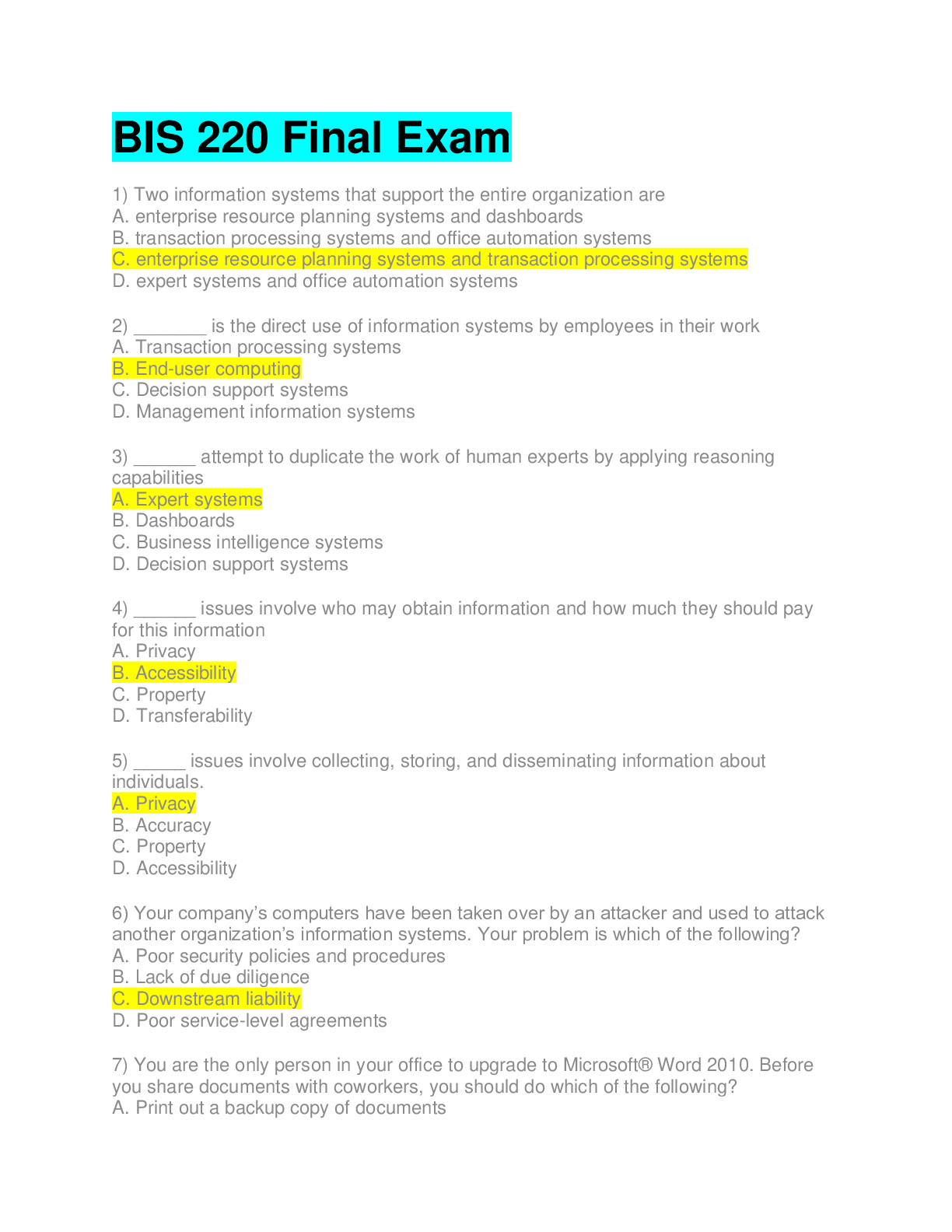
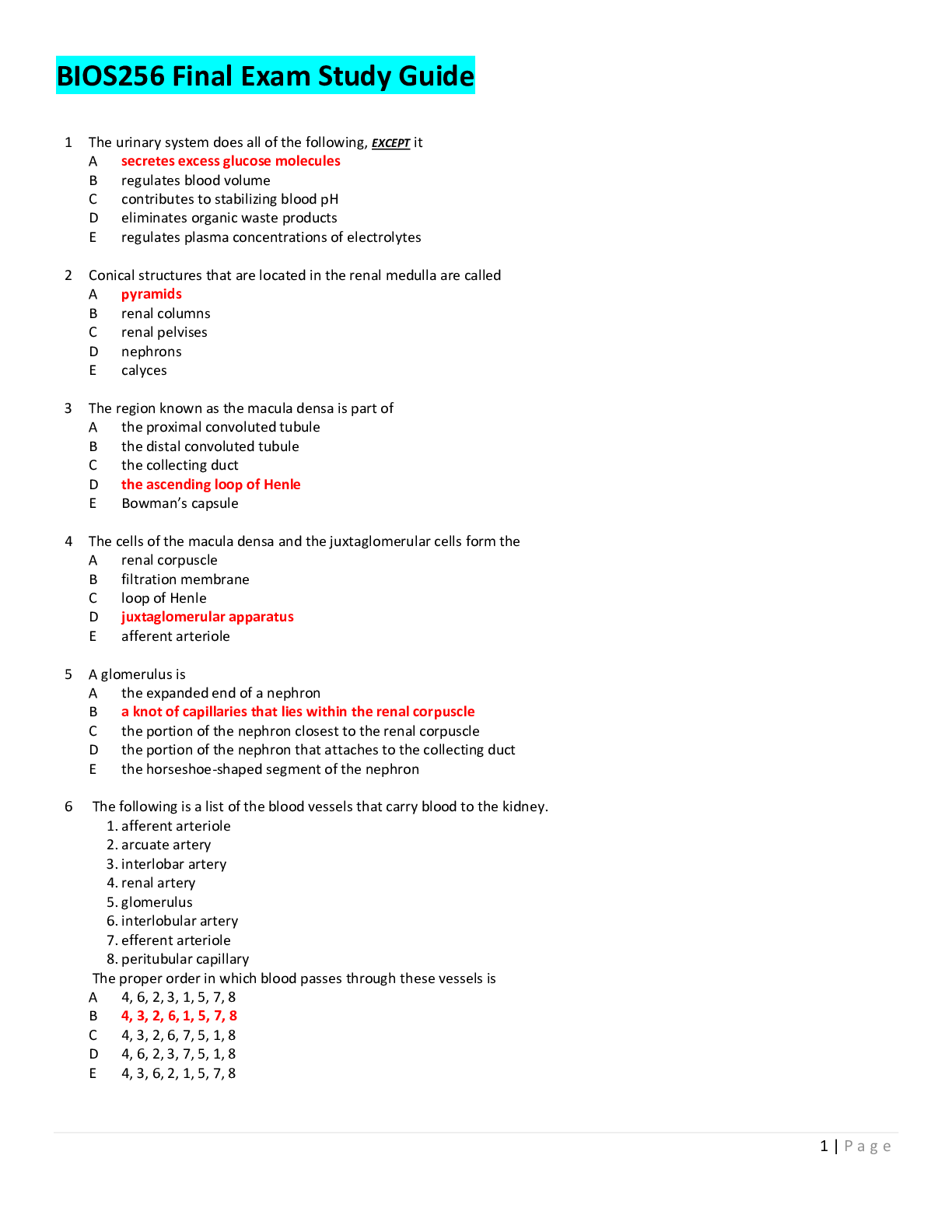


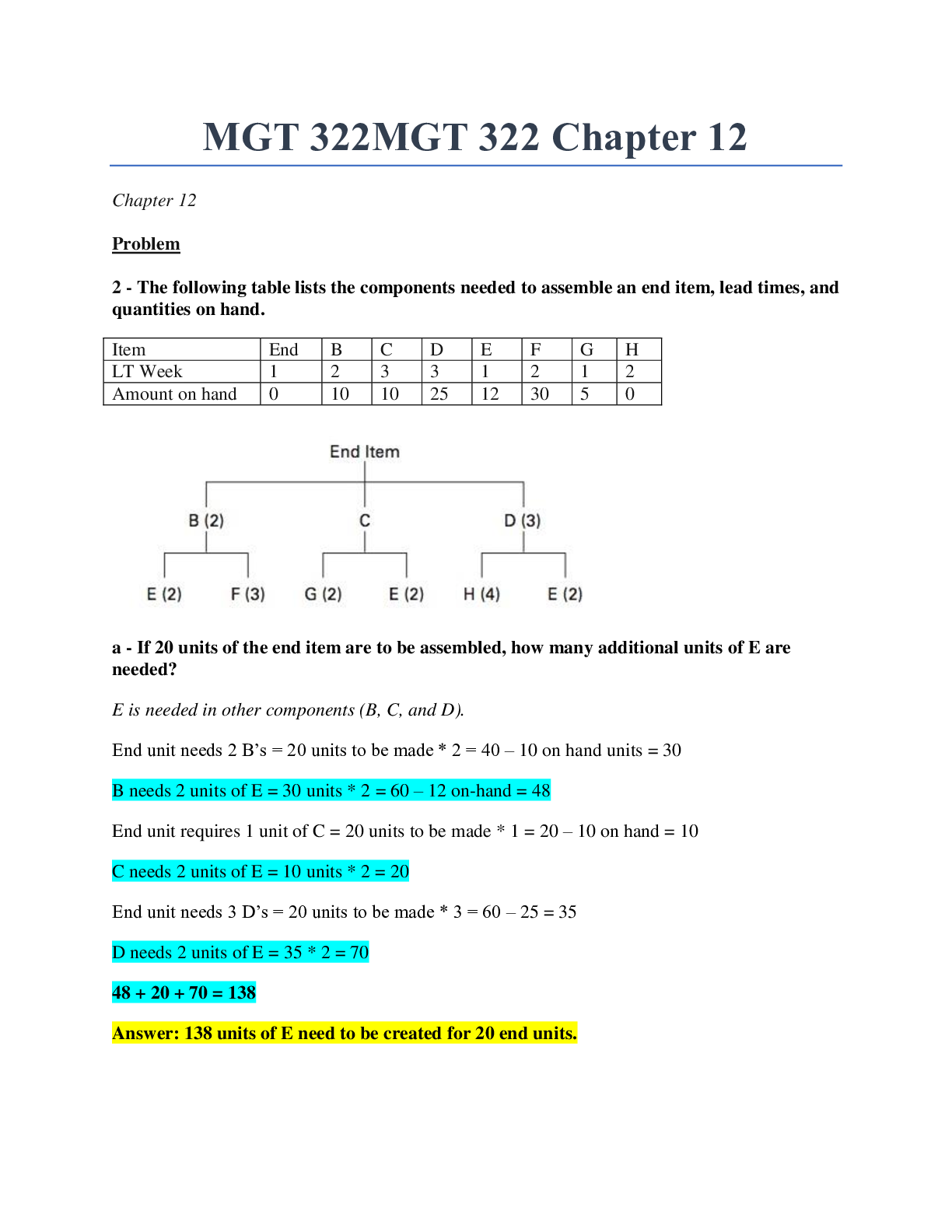
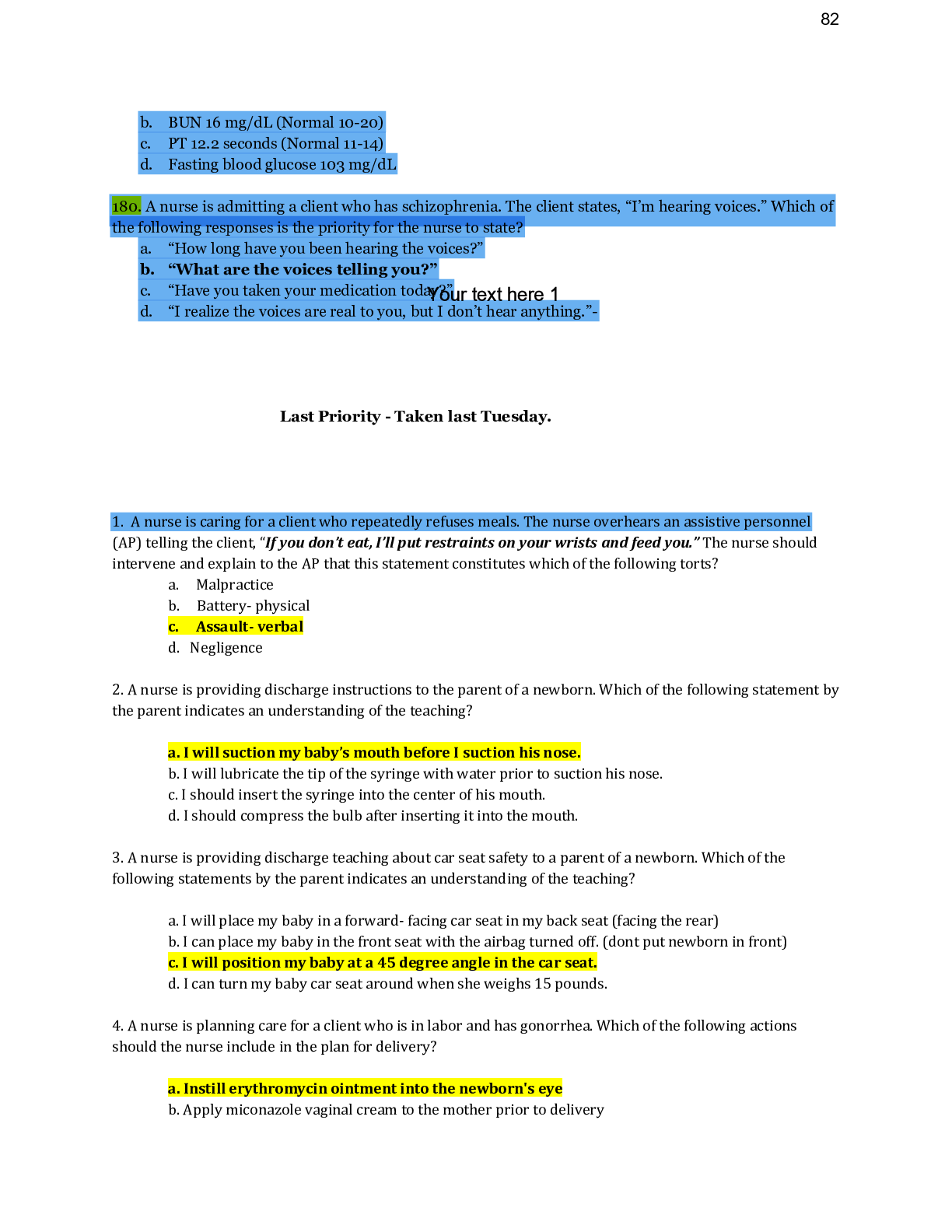
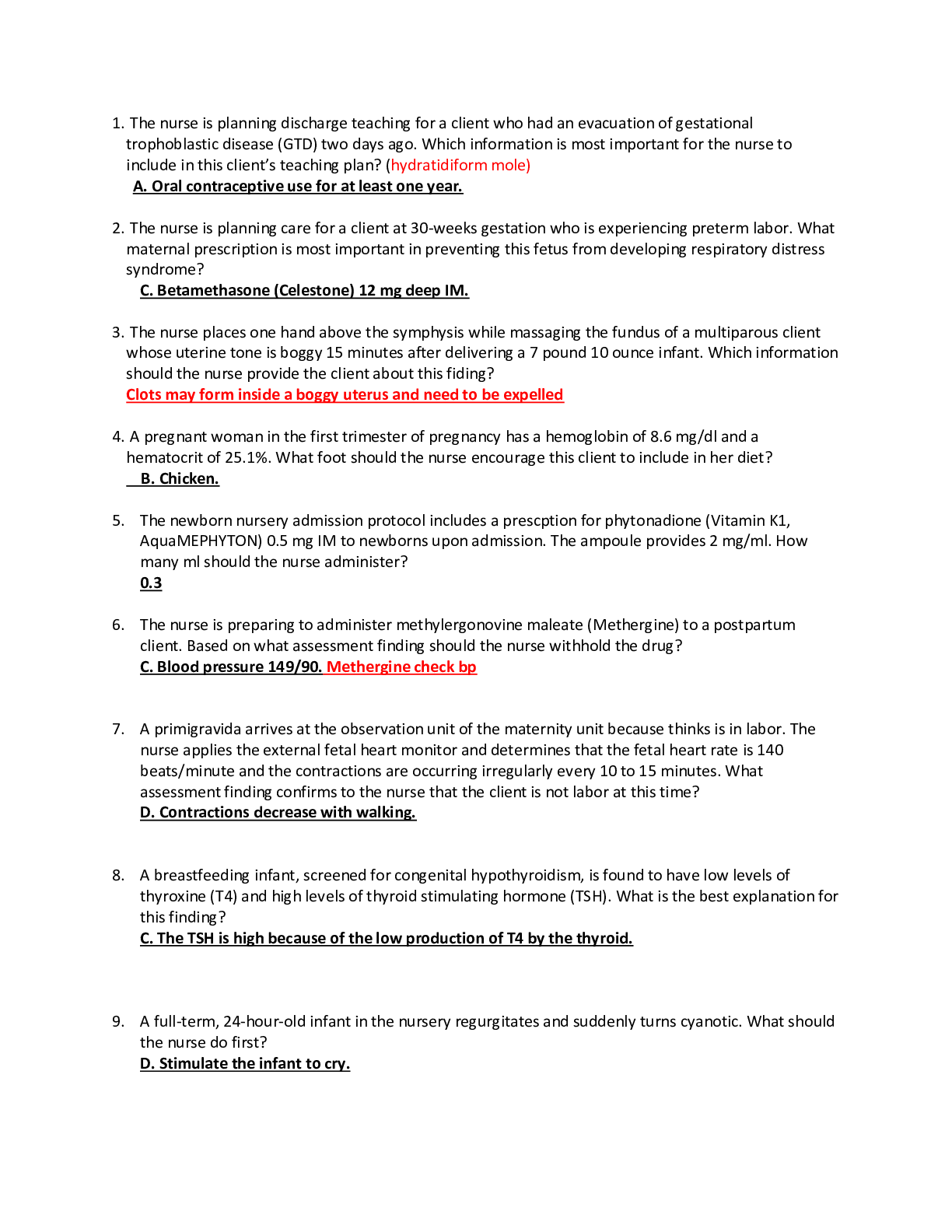
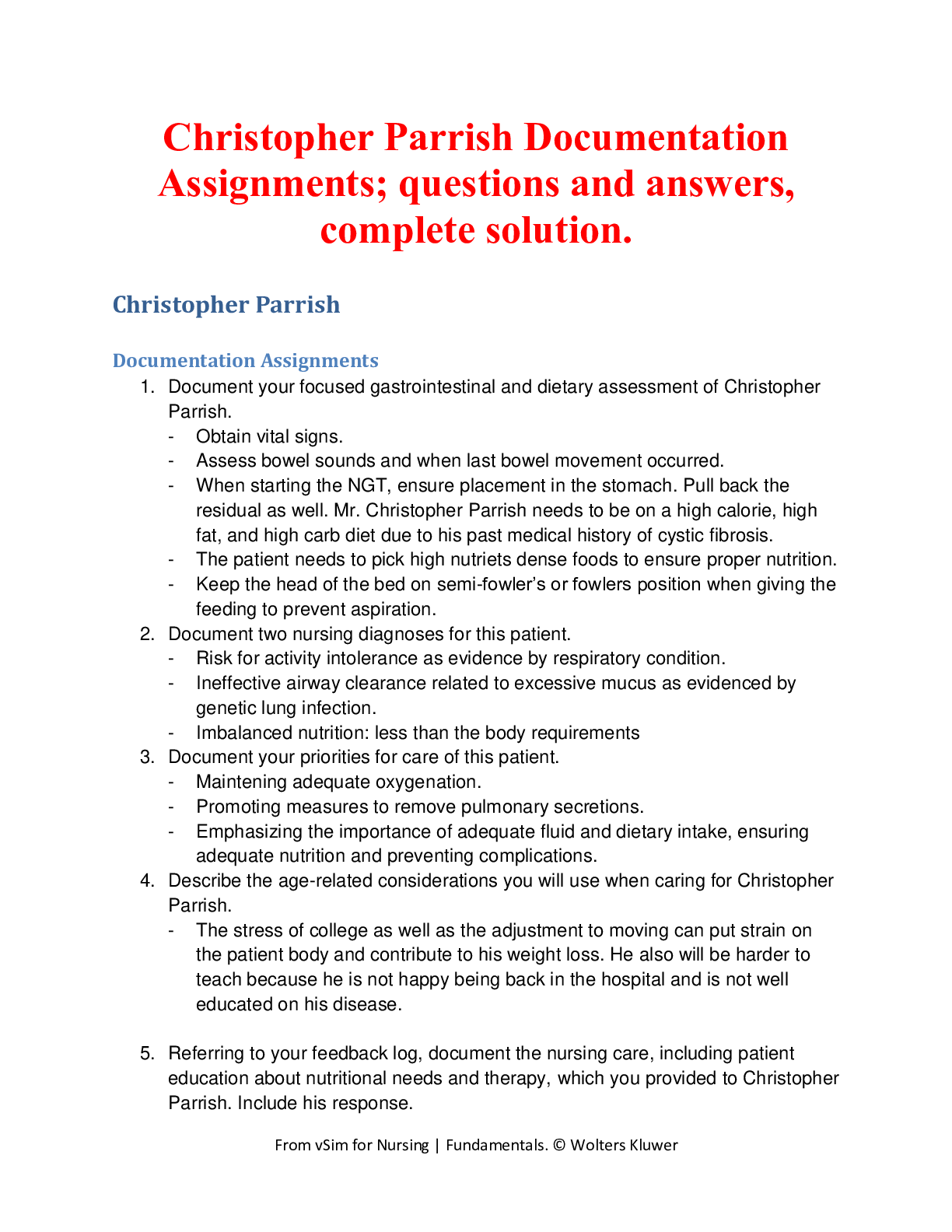
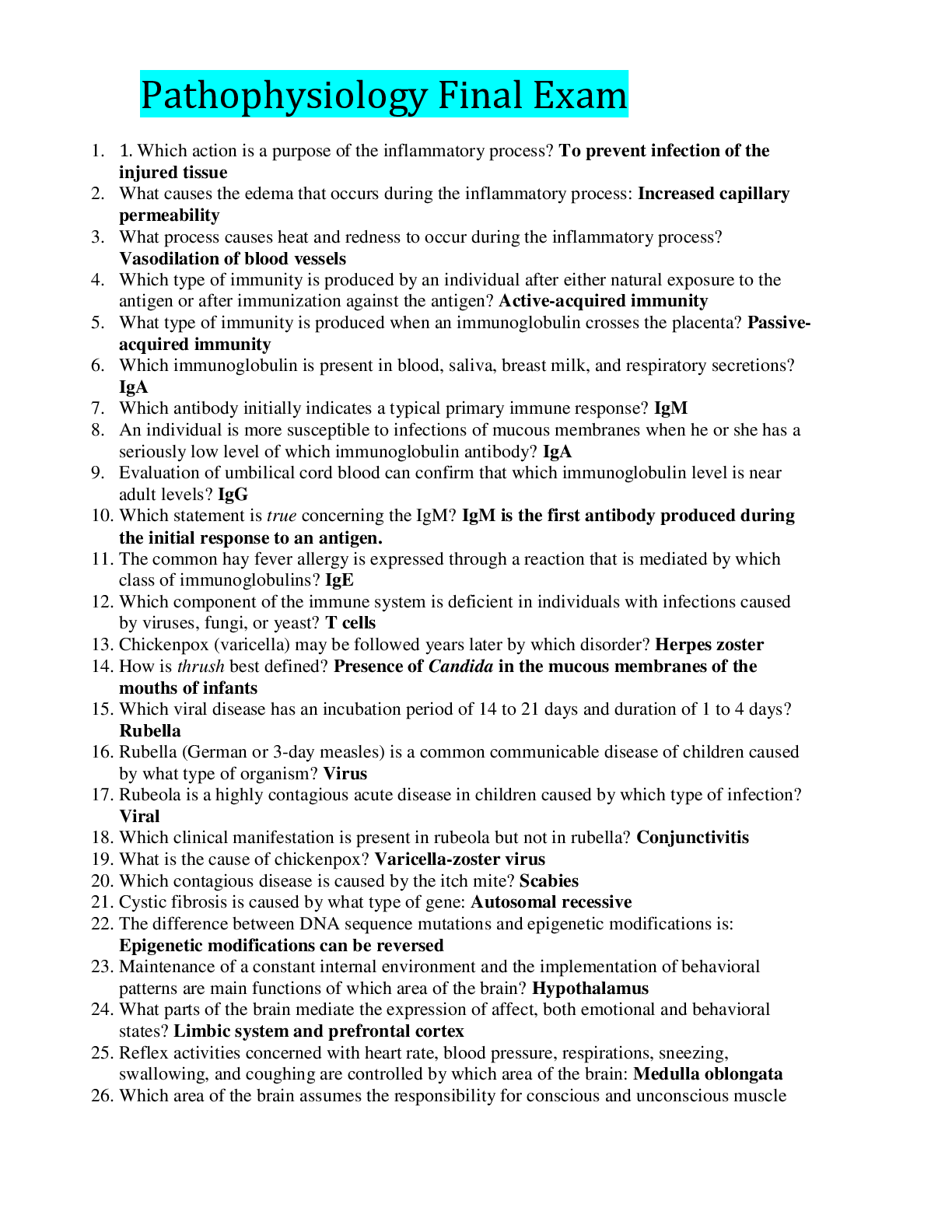
.png)
